British tanks and armored cars 1939-1945
Infantry Tanks
- A.11, Infantry Tank Mk.I, Matilda
- A.12, Infantry Tank Mk.II, Matilda II
- A.22, Infantry Tank Mk.IV, Churchill
- A.22, Infantry Tank Mk.IV, Churchill NA 75
- Infantry Tank Mk.III, Valentine
Cruiser Tanks
Medium Tanks
Light Tanks
Tank Destroyers
Tankettes
Flamethrowers
Armored Cars
Funnies
Other Vehicles
- Churchill ARV Mk.I & Mk.II
- Morris-Commercial C9/B Self-Propelled 40mm Bofors
- Sherman ‘Tulip’ Rocket Firing Tanks
- Vauxhall B.T. Three-Quarter track Traclat
Prototypes & Projects
- 40RBL78 MA Field Gun
- A.11E1, Infantry Tank, Matilda Prototype
- A.33, Assault Tank “Excelsior”
- A.34* (Star), Cruiser Tank, Comet
- A.38, Infantry Tank, Valiant
- A.39, Heavy Assault Tank, Tortoise
- A.43, Infantry Tank, Black Prince
- Ansaldo Carro da 9t
- Arthur Janser’s 500-ton Battleship and Grasshopper Tanks
- Bechhold Tank
- British Testing of the Praga TNH-P 8-ton Tank in 1938
- Churchill Mk.III with ‘Ardeer Aggie’ Mortar
- Gerrey Machine Gun Motor Vehicle
- Heavy/Assault Tank T14
- Humber Hexonaut GS 6×6
- Johnson’s Light Tropical Tank
- Kahn’s Obstacle Ball / Rolling Fortress ‘Tank’
- M.O.I. ‘Moveable Maginot’
- Morris-Martel Tankettes
- Praying Mantis
- Smeaton Sochaczewski Carrier
- TOG 300G
- TOG Amphibian
- TOG Citadel
- Vickers Amphibious Light Tank L1E3
- Vickers No.1 & No.2 Tanks
Anti-Tank Weapons
Fake Tanks
Tactics
- British Somaliland Campaign 1920
- British Tank Losses March to May 1945: The War in North West Europe
- Campaigns and Battles in East Africa – The North, British and French Somaliland
- Effectiveness of Tactical Air Strikes in World War II – “Tank busting”
- Esigenza C3 – The Italian Invasion of Malta
- Operation Sentry – The First Centurion Trials 1945
Technology
UK Vehicles in Foreign Service
- A.34 Comet in Cuban Service
- A.34 Comet in Irish Service
- Carden-Loyd Mk.VI in Belgian Service (Mk.VI with 47 mm)
- Carden-Loyd Mk.VI in Bolivian Service
- Carden-Loyd Mk.VI in Czechoslovak Service and CL-P
- Carden-Loyd Mk.VI in Dutch Service
- Carro Veloce 29
- Churchill Mk.VI in Irish Service
- Coventry Armoured Car in French Service
- Cruiser A.10 and A.13 in French Service
- Kreuzer Panzerkampfwagen Mk IV 744(e)
- Matilda Dozer
- Matilda Frog and ‘Murray FT’ Flame Tank
- Matilda Hedgehog
- Matilda II in Australian Service
- Matilda II in Soviet Service
- Matilda II Mk.IV with ZiS-5 76mm
- Mk.IX Armoured Car (Standard Beaverette in Irish Service)
- Universal Carrier in Irish Service
- Vickers Mark E in Bolivian Service
- Vickers Mark E Type B in Chinese Service
- Vickers Mark E Type B in Finnish Service
Introduction
While the British Empire was depending foremost on its navy to defend its interests, it also had modern and efficient aircraft, and a small army, but very well equipped and trained. Its armored forces were not at all numerically equal to France or Nazi Germany, but qualitatively of good level. This was the case mostly thanks to a booming export production in the thirties (mostly Vickers) and many tests, exercises and authorship of the idea of mechanized warfare (in fact the basis on which the Blitzkrieg was founded), with revolutionary concepts such as the Carden-Loyd tankette, or the adoption of the Christie suspension for its cruiser tanks.
The BEF (British Expeditionary Force) in May, 1940
In 1939, besides the colonial forces stationed around the world, mainly made up of infantry and artillery, the heavy mechanized forces were included in the British Expeditionary Force commanded by Lord Gort, formed in 1938, and landed in France soon after the declaration of war on September 3. Reduced in number (one tenth of the Allied forces, France, Belgium, Holland, Denmark included), but of very high combat value, the BEF included 158,000 men, arrived in five weeks, with 25,000 vehicles, artillery and support. Final deployment was completed in May 1940, in 10 divisions, assisted by 500 units (approximately 400,000 men). The majority of the forces were assigned to the French-Belgian border, but some units went and stood behind the Maginot Line.
These forces were highly mechanized and consisted mainly of trucks and artillery tractors, armored cars and tanks, classified according to the custom of the time, in cavalry tanks (Cruisers), Scouts (Light) and Infantry. But because of the turn of events, most of this hardware was lost on the the way to the Dunkirk beaches. Only the Matilda seemed to resist the German onslaught, when counter-attacking at Amiens, but the Germans 88 mm (3.46 in) Flak guns, superior coordination and air power definitely broke this courageous but futile attempt.
The African Campaign (1940-43)
Many of the models already developed or under development in 1940 entered mass-produced, with many versions and variants until the end of the war. However, some new tanks appeared due to the precious war experience gathered, which ultimately led to the awesome Centurion, perhaps the world’s first modern MBT or “Main Battle Tank”. The best suited tanks for armored offensive appeared to be of the cruiser gender. After the Cruisers III and IV, a complete redesign of the suspension, using for the first time the Christie system, led to the design of the Mark V Covenanter and the Mark VI Crusader.
The latter gained fame in the North African campaign, but it was obsolete by 1943 and new models had arrived: The Cavalier, Centaur and, most famous, Cromwell (Mark VII), all equipped with the new 6 pdr (57 mm/2.24 in) antitank gun, improved engine and armor.
When the African campaign started, the British armored force was left with second-rate tanks, most of nearly obsolete models, like the Light Tanks Mk.II/III, Mk.V and Mk.VI and tankettes, and the obsolete Vickers Medium Mark II. There were also a few Cruisers Mk.II/IIIs. By 1940, as the Italian threatened Egypt from their Eastern African colonies and Libya, some armored reinforcements were sent, and nearly all available tanks when, in September 1940, the Germans ceased their air offensive over Britain.
At the same time, production was re-centered around a few models: The infantry tank Matilda II, the Cruiser tank Mk.IV, and the freshly arrived Valentine. Since local Italian armor was not really impressive, the bulk of the British light tanks had been based in North Africa and in the eastern colonies (Singapore, India, Burma). By the fall of 1940 and until the fall of 1941, a not well-known offensive saw these second-rate tanks, alongside many British and Australian armored cars, fighting off the Italians in Eritrea and Somaliland (East-African campaign).
But by the start of 1941, after a series of humiliating defeats, the Regio Esercito had been pushed back and even chased out from Libya. The British forces had reached Tobruk and now threatened the Italian presence in Africa itself. Hitler, unwilling to let his ally lose this precious position against British main eastern trade roads and supply lines, sent two divisions, the core of a future “Afrika Korps”, under the command of one of the most praised German generals in history, Erwin Rommel. The year 1941 was a complete reverse of the initial successes of the British army, which was pushed back all the way to Egypt. By mid-1942, several epic battles, were tanks played a vital part, contributed to slow down the Italo-German advance, until the turning point at El Alamein.
By mid-1941, the British army had received two new tanks. First wasthe brand new Crusader, with a Christie suspension which gave, on the flat battlegrounds of the North African theater, stunning performances. But speed itself was not sufficient, especially against German tactics using bait forces and ambushing antitank units. The second tank was not British but American, on insisting British request. It was a medium tank with powerful armament -but in an awkward configuration- , good armor and mobility. Nicknamed “the Iron cathedral”, the M3 served as the Lee in US service, and the Grant in British service, with distinctive modifications. Despite its shortcomings, it was dependable and contributed to stopping the German advance literally miles from the Nile, at El Alamein, a remote railroad junction. But most of all, the future “Desert Rats” were now led by a soon iconic figure, Bernard Montgomery.
By the fall of 1942, the first British M4 Shermans arrived en masse through Alexandria harbor, but the bulk of VIIIth forces still comprised M3 Grants, M3 Stuarts, Crusaders, Cruiser III-IVs, Matildas and Valentines. All these forces were patiently and carefully gathered for the great African offensive of El Alamein (second battle), planned by Montgomery in October-November 1942. At the same time, the first US Army western front commitment of the war came in French Algeria, with operation Torch. This giant pincer movement was designed to deliver the coup de grace to the Afrika Korps and the remainder of the Italian forces, now retiring to Tunisia.
The Tunisian campaign was nothing but a though and bloody affair. Tunisian muddy winter combined with a stiffened and well-ordered fighting retreat by hardened Axis troops was not what the Allies expected, and the arrival of general Kesselring with fresh reinforcements, including the brand-new Tiger tank, further increased the Allied disarray. As a response, British armor received new anti-tank guns, but to lead the assault, they also received the heavy Churchill tank, slow but extremely resilient and versatile.
The last Crusaders had been phased out, and early versions of the Valentine had been converted with success into the Bishop SPG. Now obsolete Grants were sent to the Far East. They would go on to have a brilliant fighting career in Burma, until 1945. The Cavalier, Centaur and Cromwell, all based on the same requirements and very similar, arrived in limited numbers. Their new high-velocity gun and reliable engine proved more than a match for many aging Panzer III and IVs.
The Italian Campaign (1943-45)
The surrender of all Axis forces in Tunisia came in May 1943. The Allies, however, had not succeeded in completely destroying Kesselring’s army, which retreated in good order to Sicily. The Sicilian campaign, from July to August 1943, saw the extensive use of US Lend-Lease vehicles to compensate for the British losses, mainly Monty’s VIIIth army, comprising M2/M3 half-tracks, jeeps, trucks, M5 Stuarts, as well as M3 derived self-propelled artillery (US-built Priest and Canadian-built Sexton). During the previous desert operation, Lend-Lease Jeeps and Chevrolet trucks, modified and heavily armed, served with the famous LRDG (Long Range Desert Group), using effective hit-and-run tactics. The next campaign, starting in Italy in September at Salerno and Taranto saw a growing number of Canadian-built tanks, mainly Universal Carriers and the Sexton SPG. Now the mainstay of the British tank force, apart from the Shermans and Churchill, were the Cruiser VII (“C” models) and later versions of the Valentine. Soon after these landings, a new Italian government was formed, which decided to put Mussolini in arrest and quickly entered peace talks with the Allies. But, despite the defection of Italian troops, the offensive reached a standstill. General Kesserling was able to put a very sturdy resistance, helped by his hardened troops, some reinforcements and the Italian landscape. The Italian campaign dragged on until the fall of 1945.
D-Day and the European campaign (1944-45):
Before D-Day, the only attempted landing in occupied France had occurred on 19 August 1942. This was a complete failure, with a heavy price which was mostly paid by Canadian troops. This was also one of the first actions of the new Churchill tank. Already developed in 1941, the Churchill looked obsolete, and it was plagued by teething problems. At Dieppe, none of these heavy tanks made it farther than the beach, easy prey for the German artillery at point-blank range. The problem was not in the tank, but in the very stuff that composed the beach, tiny chert which clogged into the drivetrain and tracks. The Churchills were doomed. But this tank would prove its value in a matter of weeks in North Africa and especially Tunisia,. When all its defaults were corrected, it ended up as a very fine armored vehicle. It was extremely sturdy, roomy, reliable, and highly adaptable, and it could climb slopes impossible for any other Allied model. It became the staple of the Royal engineers for every duty imaginable, from D-Day to V-Day.
The bulk of the British tank force during D-Day was made of US-built Sherman tanks. The British were not long to grasp the potential of this tank and quickly attempted a modification of their own, the Firefly. This was basically an up-gunned version, fitted with the long-barrel, high-velocity QF 17-pdr (76.2 mm/3 in), the British perfect “tank killer”, capable of knocking out any German tank of the day. It was used in conjunction with other models and proved really up to the task during the operations in the Normandy bocage and heavy fighting around Caen. The US devised their own upgunned version, the 76(w), which appeared not long after and became the next upgrade of all Sherman versions.
The second most important British tank deployed was the Cromwell. Derived from the long line of “cruisers” and equipped with the same engine as the legendary Spitfire (the Rolls-Royce Meteor), the Cromwell was faster than the Sherman, but also lower, and equipped with the largely available and very efficient QF 6-Pdr (57 mm/2.24 in) gun. However, it was cramped and the small hatches too often condemned the crews to burn alive inside the tank. The Cromwell was chiefly used for training, and only equipped the 7th Armored Division and other elite specialized units, like the reconnaissance units attached to the Guards Armored Division and 11th Armored Division.
Other important AFVs deployed at D-Day were the self-propelled howitzers, M7 Priest and the Canadian Sexton. Indirect fire could be provided quickly thanks to these vehicles, which turned out to also be efficient troop transports. So much so, that many other turretless vehicles were called for the task, summarily called “Kangaroo“. But these converted vehicles were all open-topped. The unique SPG designed to operate as a tank hunter was the 17-Pdr Archer, based on the Valentine chassis. Around 600 were produced in 1944, and they operated in France, Holland, Germany and Italy. These were characterized by a rearward-firing configuration.
The A.30 Challenger (Cruiser Mark VIII) made its debut in France in the summer of 1944. It was introduced with the new high-velocity 17 pdr (76.2 mm/3 in) QF AT gun, capable of dealing with German Panzer IVs and Panthers. However, its development took time, and the Firefly appeared cheaper to convert in numbers. So despite its advantages (it was faster and agiler), the costly and complex Challenger never saw action before July and August 1944, when the mulberries were operational, and only 200 were built, equipping British elite units, as well as Czech and Polish ones.
Both concepts of tank hunter and cruiser tank were reunited in a single package, the Comet, first introduced by early 1945. The Comet was basically a Cromwell re-equipped with a specially adapted version of the deadly QF-17 pdr. An impressive package of speed, armor and firepower, which represented the peak of British experience facing German tanks. But it was not the last “cruiser”. As soon as 1943, the general Staff asked for a “Heavy Cruiser” (A.41), which could withstand a direct hit from a German 88, be agile like the Comet and Cromwell, still be armed with an improved version of the QF 17-pdr and stay within the 40-tons limit to allow transport by the lorries. A mock-up was built in May 1944, with prototypes in early 1945 after many revisions. It is said that three pre-series Mk.I Centurion prototypes were sent to Germany before V-day, but the armistice was signed before they could participate in any action. However, they had a great postwar career and pioneered the “main battle tank” we know today.
Armoured cars
Daimler Dingo
With nearly 6,400 machines produced in several sub-versions until 1945, the Dingo was one of the best armored reconnaissance 4×4 vehicles produced in the world. About 400 served during the campaign of France in the 1st Armored Division and the Northumberland Fusiliers; and in many theaters after.
Humber Light Reconnaissance Car
About 300 of these armored armored car were produced by the Rootes Group (Humber) and served with the BEF. These vehicles had a Boys anti-tank rifle and a Bren gun. After the Fall of France, 3600 more would be produced.
Older models
-There were still ww1 vintage or 1920-24 pattern Rolls-Royce models in use in North Africa, especially in Libya and East Africa
-The rare Vickers Crossley 4×4 (model 25) was produced for Japan, whereas 100 “Indian pattern” were used by the Raj of India and the 6×6 Mark I was still during the war for training (to come). About thirteen IGA-1s 6×6 were also used by the Estonian defence Forces in WW2 and the model 26 4×4 by Argentina.
-Guy Armoured Car: Only 101 of the “pre-production” prototypes for the famous Humber were built by Sydney Guy at Wolverhampton in 1939. Only four went with the BEF, all captured, the rest were used at home for training.
-Lanchester 6×4: A rather rare 6×6 model developed in 1928 (34 built) and used overseas during ww2 (Malaya) and at home for training. Relatively similar to the Vickers-Crossley.
New ww2 models
-Humber armored car: One of the most successful ww2 armored cars. Developed from the Guy in 1940, 5400 were produced up to 1945. Armament was variable but in general a couple of a heavy Besa and light machine guns. Used as a standard for ground reconnaissance on all fronts.
-AEC Armoured Car: A 4×4 monster built during the war and sturdy enough to sport the turret of the Valentine tank. It was one of the earliest example of a wheeled tank during ww2.
-Coventry Armoured Car: A late (1943) ww2 attempt to design a standard wheeled armored car to replace previous models, only 220 built.
-Morris CS9: Morris was a prolific prewar car manufacturer, but only produced 99 of its own armored car in 1938-39, the CS9. A sturdy 4×4 lightly armed and armored, it was quickly retired from the front line.
-Morris Light Reconnaissance Car: Designed and mass-produced after Dunkirk (1940) at 2200 units, this light RC armored car was lightly armored and protected, but cheap to built and faster than the heavier CS9. However it suffered from reliability issues and had limited offroad capabilities.
-Standard Beaverette: A desperate case of improvization, these were post-Dunkirk 1940. Called “Lord Beaverbrook’s pets” (RAF) they were hastily-made armored conversions for home guards defence. They were made of Standard car vehicles, 2,800 converted in a shot time and several series. They only served at Home.
Light tanks
Vickers Light Mk.II-III
Mk.I (10 built), Mk.II (66 built) and Mk.III (34 built), 110 built in all. From these light tanks derived many models, including the 6-ton light tank widely sold for export. They were classified as cavalry tanks, light, fast, with a turret armed with a single gun, and a crew of two. Relegated for training until 1942.
Vickers Light Mk.IV
34 of these improved Mk.IIIs with a new hull and suspensions were delivered.
Vickers Light Mk.V
22 of these three-men crew vehicles with a redesigned hull were built.
Vickers Light Mk.VI
1682 built. By far the most common light tank of the BEF, the Mk.VI was produced until 1939, of which many were sent overseas. It used a heavy .50 cal (12.7 mm) machine gun, combined with a light machine gun (7.7 mm/0.3 in).
Tetrarch (Tank, light, Mk.VII)
177 built. The A.17 was a specific wartime version designed to be airborne. The Tetrarch served in Normandy, but, being unsatisfactory, they were quickly withdrawn. Next, was the Harry Hopkins, a disastrous model.
Tank, light, Mark VIII “Harry Hopkins”
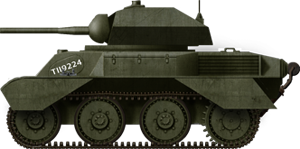
The Tank, Light, Mk.VIII (A.25), better known as “Harry Hopkins”, was a British light tank made in just 100 vehicles by Vickers-Armstrong specifically for airborne operations. It was also the very last of the long line of British light tanks and successor to the Mk.VII Tetrarch. Compared to the latter, it was larger and had a better armour. Submitted to the War Office in late 1941, the design was accepted and an order for 1,000 was approved by the Tank Board (War Office), later increased to 2,410 in November 1941. However production only started by June 1942 and early exercises underline a great number of problems, requiring a stray of modifications of the design as production was ongoing. Complaints accumulated at the War Office from the Fighting Vehicle Proving Establishment. The issues were such that only six Hopkins tanks had been delivered by mid-1943, and the serie went on until reaching 100 in February 1945 before being cancelled.
By mid-1941 already, some in the War Office and British Army estimated that light tanks were no longer desirable, lacking armament and armour, and often foreshadow in their scout role by cheaper armoured cars. In general they performed poorly in many engagement. For the Mk.VIII this meant they were already undesirable and were in addition obsolete when the production ended. In fact none ever saw combat. Reconversion plans were made by the War Office like having reconnaissance units fielding these, attached wings tests, to be towed as gliders, but nothing really worked. By default of other ideas, they were handed over to the Royal Air Force, and used use in airfield defence. The Mk.VIII only variant was the short-lived Alecto self-propelled gun, using a howitzer for paratroopers close-support artillery in airborne operations, but only a few were produced, only tested, never fielded in active units.
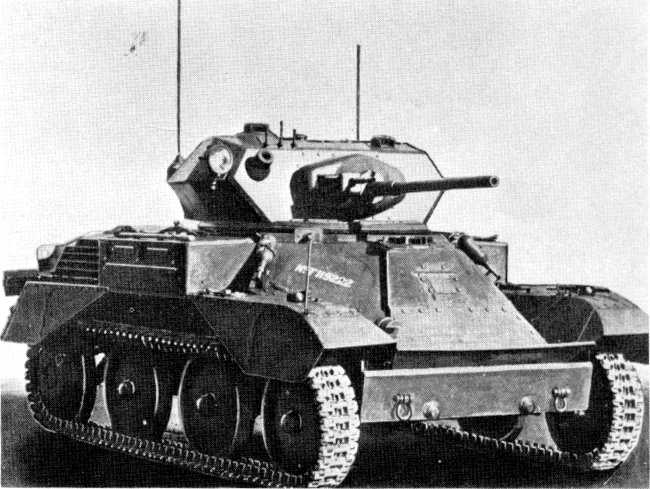
Medium tanks
A.9, Cruiser Mk.I
125 built in 1938. Designed in 1937, a development of Major Giffard Le Quesne Martel’s tankettes, these medium tanks were the forerunners of the famous Crusader.
Cruiser Mk.II
175 built. Closely derived from the Mk.I, it was equipped with a 2-pounder (37 mm/1.47 in) high-velocity gun, a heavy Besa machine-gun and a coaxial Vickers machine gun.
Cruiser Mk.III
65 built. Derived from the Mk.II, this new medium tank had a Christie suspension, giving it a much better grip on rough terrain. They were built in part for the BEF, but quickly supplanted by the Mk.IV.
Cruiser Mk.IV
890 in all (225 Mk.IV and 665 Mk.IVA). Based on the Mk.III with improvements but with a far superior, sloped armor. It was widely used in North Africa .
Cruiser Mk.V Covenanter
1771 built in 1940-42. A largely improved Cruiser, built by LMS/Nuffield, which suffered from many design flaws, despite being the blueprint of the Crusader. It saw little combat and was mostly used for drilling.
Cruiser Mk.VI Crusader
5,300 in all. An all-around superior tank to the previous Cruisers, it made up the bulk of the British tank force during the African campaign. But, suffering from engine problems, relatively weak armor and armament, it was phased out in 1942.
Cruiser Mk.VII Cavalier
500 built. Also known earlier as the Cromwell I or A.24 (Nuffield), it was basically an improved Crusader with a new turret, armor and 6 pdr.
Cruiser Mk.VIII Centaur/Cromwell
4,016 built until 1945. Improved version of the Cavalier or A.27L (the Centaur was at first known as the Cromwell II) with a Liberty Engine (by Nuffield). The Cromwell proper (A.27M) was propelled by a more powerful Rolls-Royce Meteor, an adaptation of the famous Merlin propelling the Spitfire.
Cruiser Mk.VIII Challenger
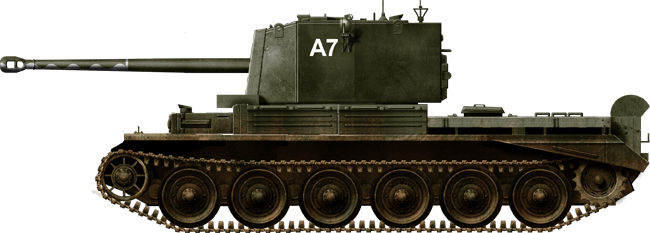
This 1942 project, headed by Roy Robotham, was meant to carry the long 17-pdr gun. On paper, this was quite a formidable anti-tank gun, but incompatible with the turrets of the Crusader and Cromwell series. It was realized that the new tanks (Comet and later Centurion) would need at least two more years of development, so an interim solution was chosen with the modification of a Cromwell tailored to carry a larger turret ring for the 17-pdr.
This resulted into the A.30 design, basically a stretched-out Cromwell with an extra pair of roadwheels and many other modifications, including the removal of the bow machine gun to free space for the bigger rounds. The new turret was taller and, due to the strain added, compromise led to it having thinner armor than actually found on the Cromwell. After production started in February 1943, with 200 Challengers built by Birmingham Railway Carriage and Wagon Company, the General Staff declined any further order and canceled the project in November of that year. The few Challengers built acted as tank hunters until the end of the war. They arrived in operations in August 1944 in Normandy, then northern France and the Low Countries. Many served with the 1st Czechoslovak Armoured Brigade and 22 were found in service in the Czechoslovak army until 1951 when provisions of Soviet-built tanks made it obsolete.
Derivative: The A.30 Avenger tank hunter
The Challenger’s turret problems were later to be solved by a tank hunter, developed in 1944 by Leyland motors. It reused most of the Challenger, swapping to the Comet’s suspensions in late production (1945). This peculiar vehicle was the A.30 self-propelled gun, Avenger. just like the Achilles, a conversion with the 17-pdr of the American M10 GMC Wolwerine, the Avenger had a lower, thicker open top turret, which just a small cover for the crew. It was not very successful and of the 230 ordered, it seems only about 60 were delivered as the order was cancelled in May 1945. None was used during the war, but they made two tank hunter battalions until 1952, discarded afterwards.
Comet
1,186 built in 1944-45. A product of Leyland motors, carrying the 77 mm (3 in) gun, better known as the legendary 17-pdr, the best piece of AT ordinance in the Allied arsenal by 1943. The Comet was also designed to correct the Cromwell’s flaws (track shedding and broken suspension problems).
Infantry Tank Mk.I Matilda I
140 built. This vehicle was slow and very well protected, with a simple caliber .303 (7.62 mm) heavy machine gun, it was a testbed for the next, better known Matilda II.
Infantry Tank Mk.II Matilda II
2,987 built by 1939. Called A.12, Tank, Infantry, Mk.II, it was a major best-seller among the British models. By 1939, about 300 were produced. They were a little faster, had a powerful and economical diesel and a high-velocity 2-pounder gun (40 mm/1.57 in). It was twice as massive and overall better protected than the Matilda I. Heavy tank by the standards of 1939.
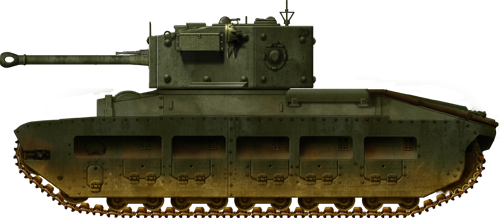
Matilda Black Prince, click the picture for more.
Infantry Tank Mk.III Valentine
8,300 built until 1943. Designed internally by Vickers without a specific request from the War Ministry, the Valentine infantry tank was more compact and lighter than previous tanks of the type. It was not a priority, but received the endorsement of the War Office after the Dunkirk evacuation, being produced in many versions, steadily improved until the Mk.XI of 1943.
Infantry Tank Mk.IV Churchill
7,368 built. The Tank, Infantry, Mk.IV was one of the heaviest, but also most dependable Allied tanks during the war. Its sturdy chassis and well-protected hull served for many conversions and utility versions: bridge layer, minelayer/minesweeper, AVRE (Royal engineer corp), Petard (mortar), Oke and Crocodile (flamethrower), ARV (recovery), ARK (ramp).
Others
Bishop SPH support artillery
149 built in 1941. Converted Valentine with a protected QF 25-Pdr (87.6 mm/3.45 in) howitzer
Archer SPG tank hunter
660 built. Tank hunter armed with the 17 Pdr gun on the Valentine chassis, 1944.
Sherman Firefly
2,000 built. Tank hunter armed with the 17 Pdr (76.2 mm/3 in) gun on the Sherman chassis, 1944.
WW2 British Tanks more in detail
(And Tanks missing as posts for now).
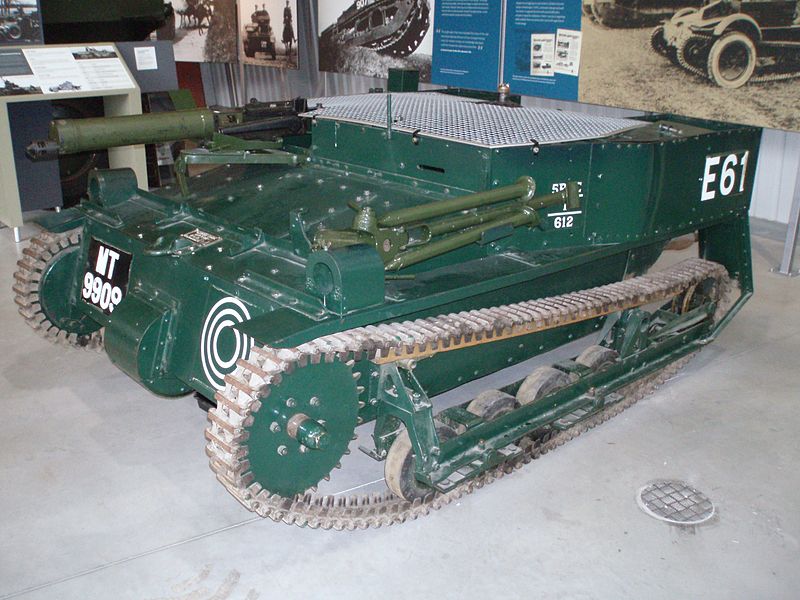
The Vickers-Carden-Loyd Mark.VI was the most exported and most produced tankette, from 1927 to 1935. Born as a concept from army engineer Major Giffard LeQuesne Martel, it reduced the armored mobility concept to its very core. 450 were built, most exported, although many served with the British armored forces. They were discarded and phased out to training duties by 1939. The tankette fad lasted until 1939. Photo credits: Flickr, dave Highbury, Bovington Tank Museum (wikimedia commons)
The Vickers 6 ton (Mark E) from 1929. With its twin turret and one turret versions, it was another one of the firm’s outstanding export successes. 13 countries bought it. The first customer, the USSR, developed the T-26 and the Polish firm Ursus developed the 7TP. Here is a Portuguese Vickers Mark E Type B (37 mm/1.46 in)

The Vickers Medium tank Mk.I was another famous interwar British tank. It belonged to the early twenties generation, fitted with a full traverse three-man turret (for the first time in the world), a new suspension system, and a quick-firing 3 pdr (47 mm/1.85 in) gun. 200 were built and phased out for training in 1938. The next Medium Mk.II was mostly similar. Production stopped in 1934. Many were reactivated and served in secondary duties during the early phases of WW2. They were slow, badly protected and their suspension too weakly built to sustain any damage.
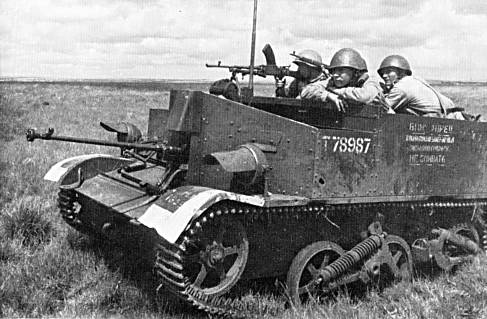
Probably the most successful of all tankette derivatives, the famous “Universal Carrier” was mass-produced to such an extent that it became the prime scout and armored mover of all Commonwealth forces, being largely supplied to the Soviets (like in this picture), Free Polish, Free French and other allies during World War Two. It was very fast, reliable, but lightly armed and protected only against small arms fire. It was also produced and used in large numbers by the Canadian army.
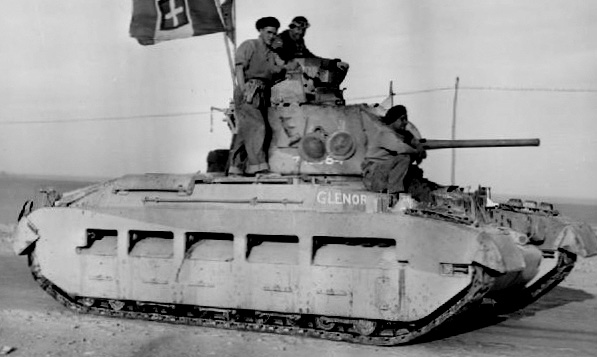
The Matilda I was a new generation specialized infantry tank. But this cost-saving model was quickly replaced by the much more efficient Matilda II, which became famous during the early phase of the war (1940-42) in Africa. Although very slow, its armor could stand against everything except the deadly German 88.
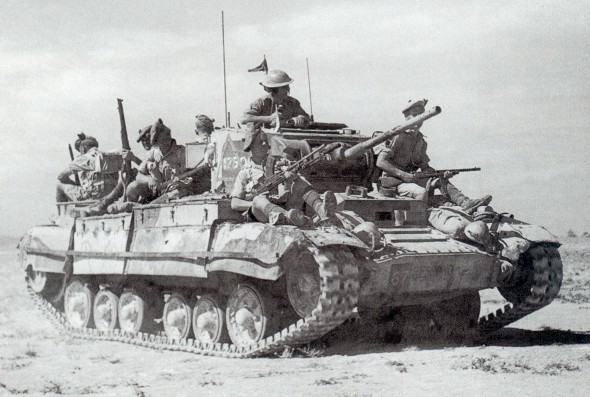
Conceived as the Tank, Infantry, Mk.III, the Valentine was a compromise between the speed of the Cruiser IV and the sturdiness of the Matilda II. It was declined into eleven versions throughout the war, with a total production of 8275, the biggest British wartime tank production ever.

The Churchill was the last infantry tank. This good all-around heavy tank was at the forefront of the British armored force from 1943 to 1945. It started with teething problems in 1941, and failed miserably at Dieppe. However, in Tunisia, this model proved its superb climbing abilities and out of the ordinary sturdiness. It was used for any kind of support and genie missions imaginable.

The Cruiser I was the first of a long line of early cruiser tanks, a new breed of cavalry tanks designed to exploit a breakthrough. Unfortunately, their top speed was unsatisfactory since they had a classically sprung suspension. The up-armored Cruiser Mk.II, was too slow to operate effectively as a cruiser, but the Mk.III and Mk.IV, featuring a Christie-style suspension, were a real improvement and regained the edge.

The Cruiser Mk.IV was very similar to the Cruiser III, apart from the turret design. Very fast, it appeared ideally suited for desert warfare.

The Cruiser V Covenanter (named after the Scottish Presbyterian movement) was a much-improved evolution of the Mk.IV. Production was first ordered in April 1939, featuring innovations like an opposed-piston engine, the front placement of cooling radiators, and the wide use of welding for the hull construction. However, it was kept chiefly for training, and inspired the more famous Cruiser VI.
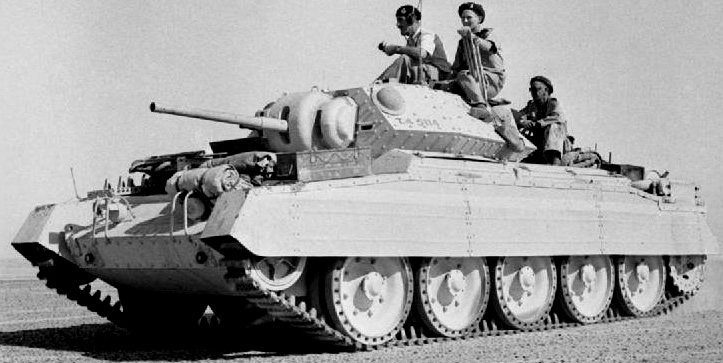
The Cruiser VI, better known as Crusader, was the most famous cruiser tank using the revolutionary Christie suspension. Its top speed largely compensated for its light armament and average protection. It was, however, the war horse of many operations throughout the North African campaign, and one of its most distinctive symbols.
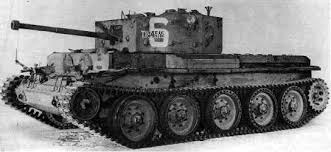
Although similar, the Cruiser VIII Centaur and Cavalier differed by the choice of their engine. They had a new QF 6-Pdr (57 mm/2.24 in) gun and good protection, while retaining a low profile and excellent speed of previous cruisers.
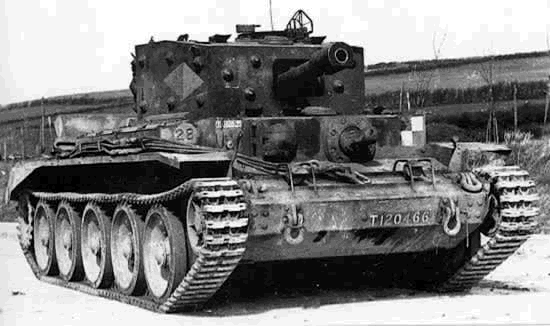
The Cruiser VIII Cromwell was the one fitted with the Rolls Royce Meteor engine, and most successful of the three. It was introduced in 1943, declined into many variants. It soldiered until the end of the war.
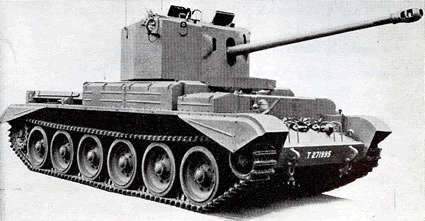
The Cruiser VIII Challenger was based on the previous Centaur/Cromwell, but fitted with a devastating 17-Pdr (76.2 mm/3 in) gun. Although promising and liked by its crews, it was dropped in favor of the Sherman Firefly.

Developed after a long line of Crusader successors, the Comet was the last of this “cruiser” generation, and the best overall. It arrived in late 1944, ready for post D-Day operations in Europe, and opening the way for the postwar generation of British tanks led by the legendary Centurion.

The 17 pdr (76.2 mm/3 in) Archer, built over surplus Valentine chassis, was a British SPG tank destroyer. It was designed to make use of the 17-Pdr in its original form, but had it mounted facing the rear of the tank.
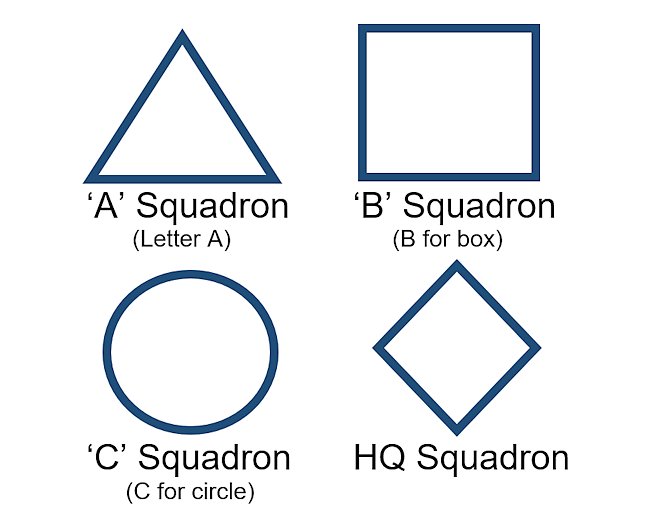
British tank squadron markings. The color changes depending on the regiment, but they normally used the same shapes.
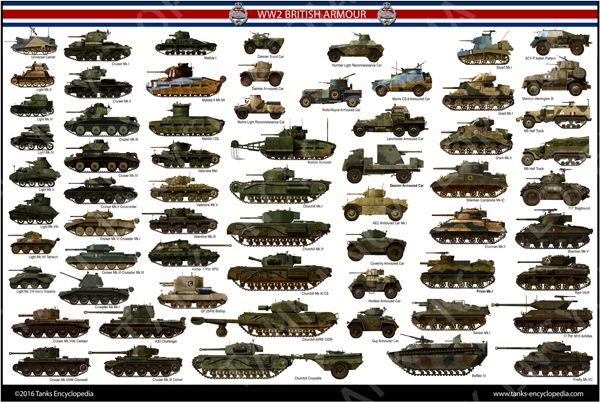
British Tanks of WW2 Poster (Support Tank Encyclopedia)
Illustrations
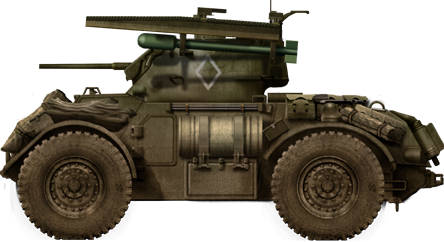
The turret of this Canadian 12th Manitoba Dragoons Staghound Armored Car was fitted with four 60 lb RP-3 (Rocket Projectile 3-inch) air to ground aircraft rocket launcher rails in November 1944.

A.10 Cruiser Mk.II in early configuration, with three .303 (7.62 mm) Vickers liquid-cooled machine-guns. It was part of the 21 delivered which were later sent with the British Expeditionary Force (BEF) to fight in France.
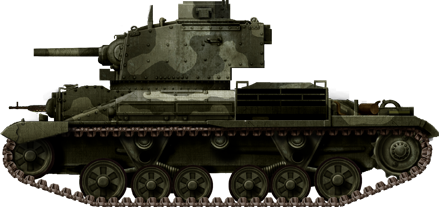
Cruiser Mk.IIA CS (Close Support) with the BEF, 1st Armoured Division, France, May 1940.
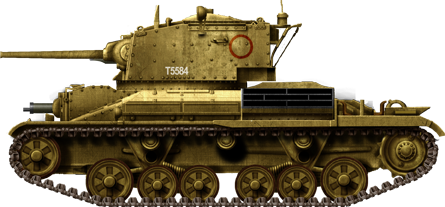
A Cruiser II defending Tobruk, during the aftermath of the Italian invasion in December 1940.
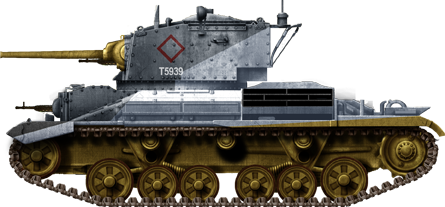
A Cruiser Mk.IIA (Besa machine-guns) during Operation Compass, the British counter-offensive against Italian forces in Libya, January 1941. The last surviving Mark IIAs were phased out by late 1941.
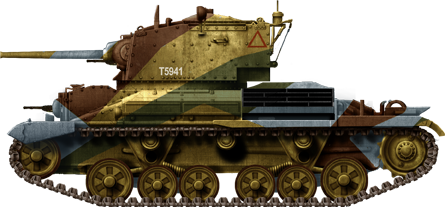
A.10 Cruiser Mk.IIA in Greece, 3rd RTR, April 1941. 60 were shipped from North Africa to Southern Greece to support the Greek defenders against much superior German Forces.
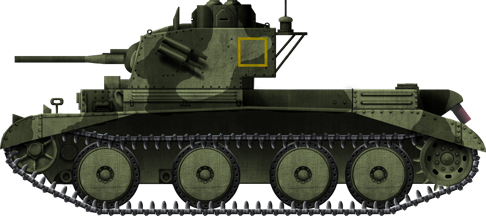
Cruiser Mk.III during the French campaign, B Squadron, 3rd Battalion, Royal Tank Regiment, 3rd Armoured Division, May 1940.
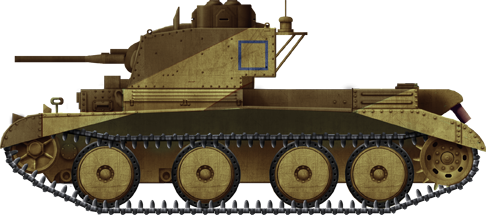
Cruiser Mk.III of the 7th Royal Tank Regiment, 7th Armoured Brigade, Operation Crusader, Libya, December 1940
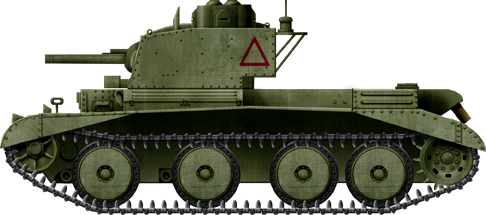
Cruiser Mk.III CS (Close Support)
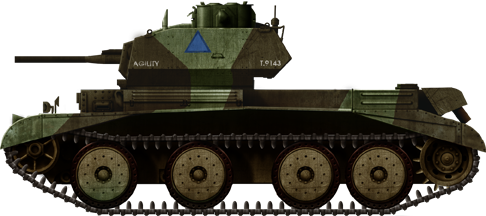
Cruiser Mk.IV from the 10th Hussars, 2nd Armoured Brigade, 1st Armoured Division, BEF, 1940
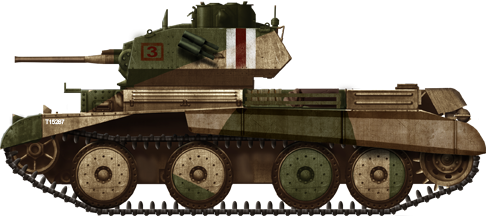
Cruiser Mk.IVA, B squadron, 7th Queens Own Hussars, Libya, 1941
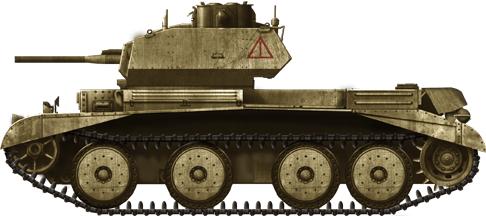
Cruiser Mk.IVA, 7th Armoured Division, Egypt, 1941.
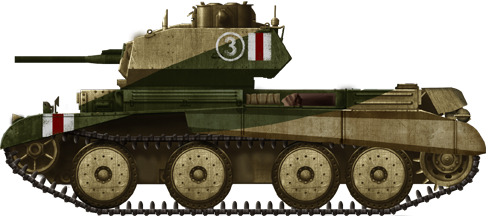
Cruiser Mk.IVa, Greece, 1941.
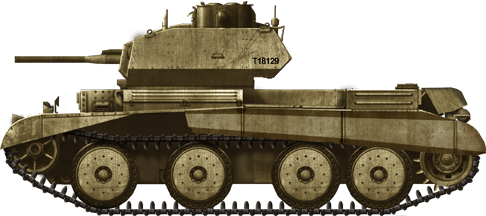
Cruiser Mk.IV, 7th Infantry Brigade decoy force, Cyprus, 1942.
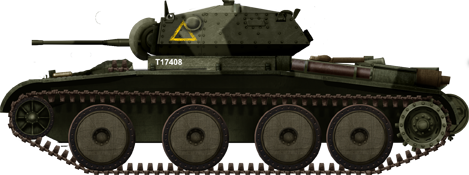
Covenanter Mark I, early production version, summer 1940.
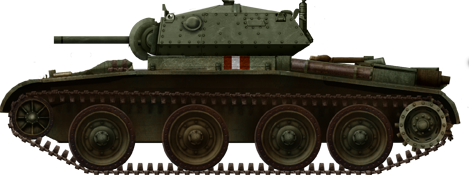
Covenanter Mk.I CS
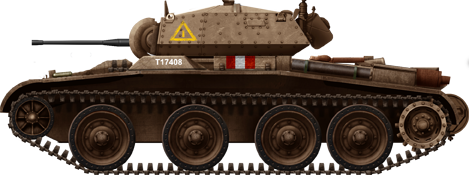
Covenanter with a brown livery, 18th Hussars, 9th Armoured Division, 1941-42.
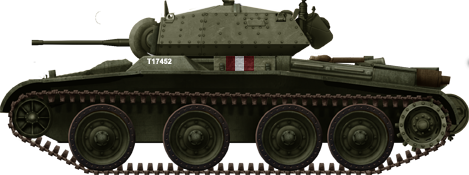
Covenanter Mk.II
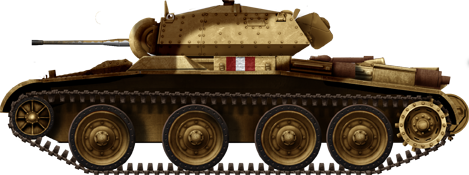
Covenanter Mk.III in North Africa, King’s force, fall 1942.
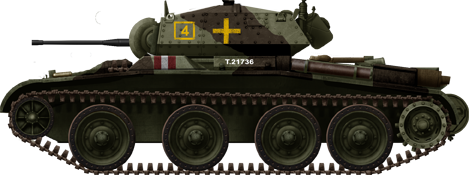
Covenanter Mark III, late production version, 9th Armoured Division, 1943.
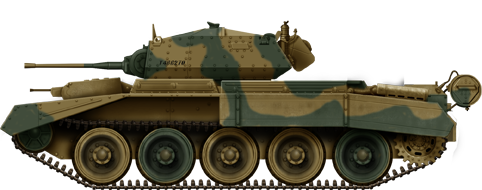
An early production Crusader Mk.I, Libya, Operation Crusader, November 1941.
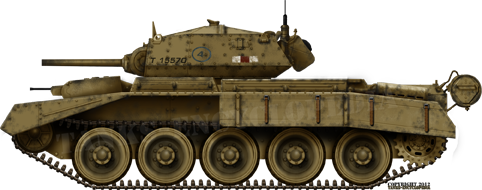
A Crusader Mk.I CS (Close Support). These converted versions were equipped with a 3.7 in (94 mm) L15 howitzer firing smoke rounds. Gazala, December 1941.
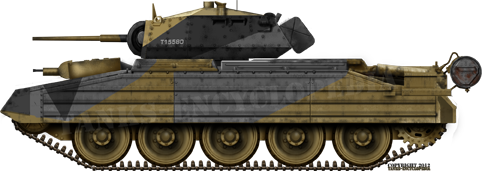
Late Crusader Mk.I. These models incorporated modifications gained from early desert war experience, like a slightly better ventilation system, to try to prevent the engine of overheating, and better, full side, fixed protective panels.
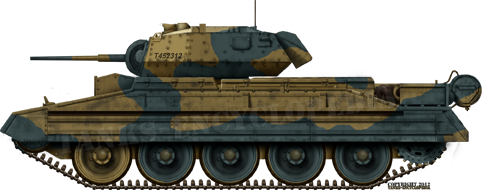
A Crusader II of the 9th Queen Lancers, attached to the 1st Division, Libya, December 1941. Besides the new protective panels and some minor alterations, the Mark II were pretty close to the previous Mark I. They even retained the auxiliary forward turret, usually removed soon after arrival on the front.
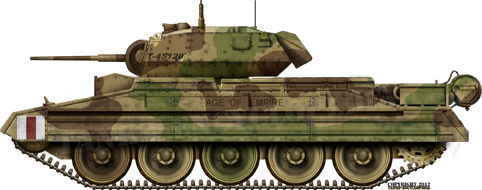
A Cruiser VI Crusader Mark II of the 22nd Armoured Brigade in Libya, December 1941. This three-tone pattern was rare.
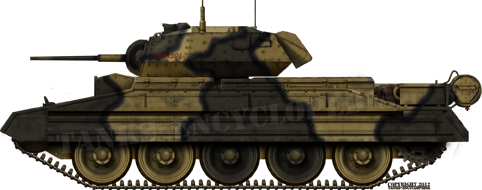
Late production Crusader Mk.II. Unknown unit, Gazala, May 1942. By the beginning of the second battle of El Alamein, almost all Mark I and IIs had been removed from the frontline, replaced by more recent Mark IIIs.
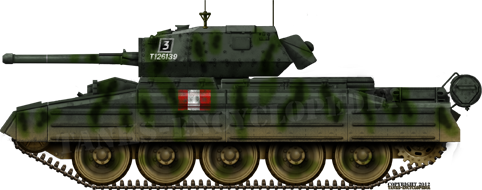
Crusader Mark III from the 6th Armoured Division, February 1943, showing a green pattern with dark green, blended stripes. Crusaders were often painted “on the spot” with available colors and depending on the season and landscape, as there were few regulations on this matter.
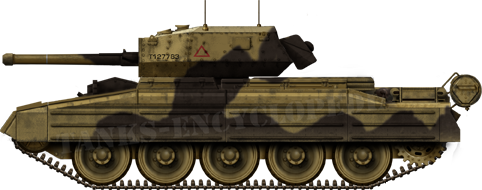
A Crusader Mark III, one of the only 100 which fought in October 1942 during the second battle of El Alamein.

Cruiser VI Crusader III of the 17th/21st Lancers, 6th Armored Division, Tunisia, November 1943.
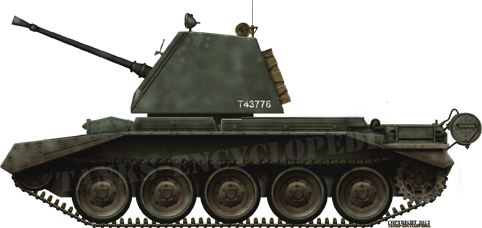
Over 1373 Crusaders were converted for special purposes, of which around 400 were Crusader AA Mark Is. They were armed with a Bofors 40 mm (1.57 in) gun, bringing its highly recognizable “pom-pom” sound on the battlefield, which gave it its popular surname among soldiers and Royal Navy sailors as well. This was the first conversion of existing Mk.III hulls. At first, the gun was just mounted on an open platform with its regular front flat shield. But it soon became obvious that better protection was needed and a four-side, open-top shield was wrapped around for the next batch of late production models.

A Crusader AA Mark III, with its distinctive twin 20 mm (0.79 in) Oerlikon mount. It had a devastating combination of speed and firepower, especially deadly for low-flying aircraft. They were coupled with a targeting .303 (7.7 mm) Vickers machine gun. These guns were balanced by a large metal cylinder mounted on a threaded rod, for adjustment. They could fire almost vertically. The Mark II and III only differed by the radio position, moved from the turret into the hull, for added free space. They were put in use in the later stages of the African campaign, in Tunisia, and fought in Sicily, Italy and Normandy. There, Allied air dominance was such that they were relegated to secondary duties. Production records are scarce but, in June 1944, 268 of these Mk.II/IIIs were enlisted for D-Day. First tests began in June 1943, and conversions started in October. Normal provision was 600 rounds.
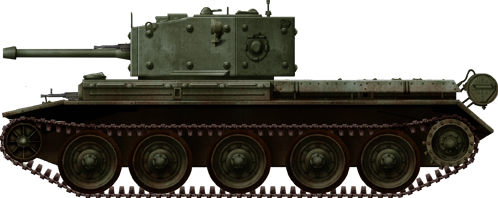
Standard Cavalier used for training in Great Britain, fall 1942. The Cavalier was basically an up-armored and redesigned Crusader. The engine and transmission as most of the technical parts were identical. The easiest points to distinguish the Cavalier from the Centaur and Crowmell are the redesigned rear (due to the transmission), positioning of the rear extra fuel tanks, and absence of the exhaust vent on the engine deck behind the turret.
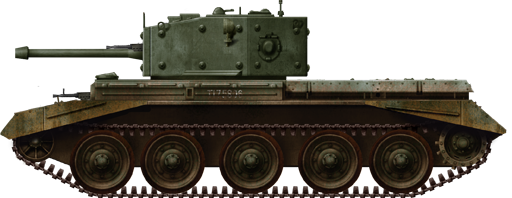
A.24 Cavalier with mudguards, from a training unit in Great Britain, 1943. There is a mislabeled “Cavalier” at the Saumur Museum, with a beige-dark brown camouflage pattern and active units symbols, which in reality could be a Centaur or Cromwell CS. Since a few “Cavaliers” were donated to the French forces in 1945, this is probably the origin of the error.
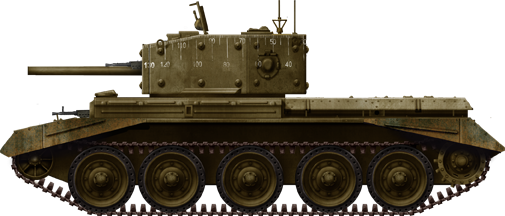
Cavalier OP (Observation post), Great Britain, 1944.

Cavalier ARV (Armored Recovery Vehicle) in Holland, 1945.
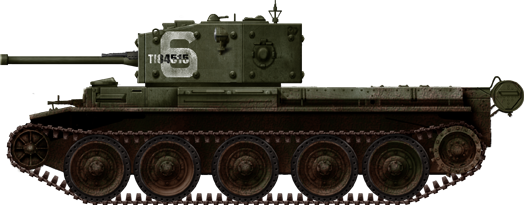
Centaur Mark I, Great Britain, December 1942.
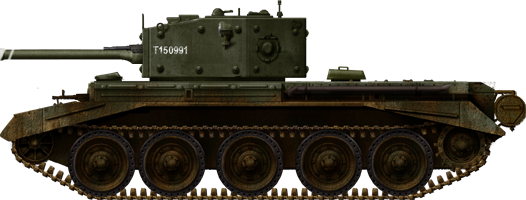
Centaur Mark III, training unit in Great Britain, mid-1943.
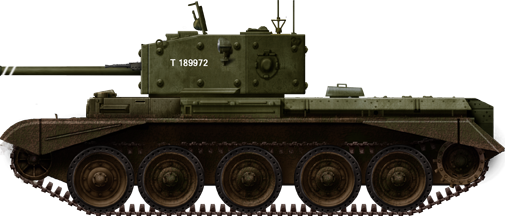
Polish Centaur III of the 14th Jalzowiecki Lancers Regiment, 16th Independent Armored Brigade, in a training unit in Great Britain, May 1944.
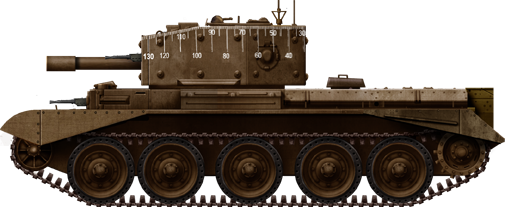
Centaur IV CS (Close Support), Normandy, summer 1944.
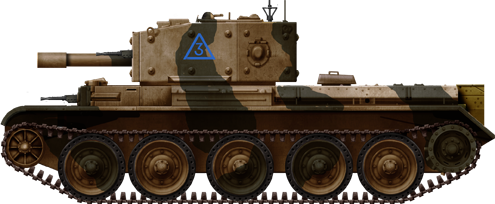
Camouflaged Centaur IV CS, as preserved at the Saumur tank museum.
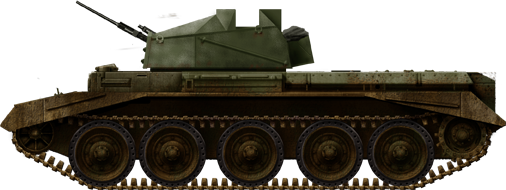
Centaur Mark I AA, Normandy, July 1944.
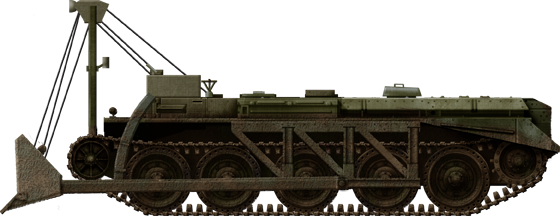
Centaur ARV Dozer of the Royal Engineers, summer 1944.
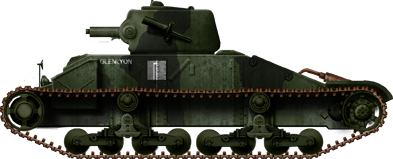
Infantry tank, Mk.I (A.11). The first Infantry Tank was completely overshadowed by the Mark II, a completely different model, better known as the Matilda. This designation is often incorectely used as a nickname for the awkward, duck-tail look of the first infantry tank.
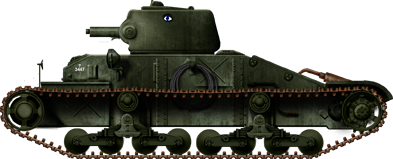
Infantry Tank Mk.I, 1st Army Tank Brigade, defense of Arras, 15 May 1940. This unit fought against Panzer IIIs and IVs of general Rommel\’s 7th Panzer Division. Many surviving Matildas were left in France, most sabotaged, before and during the evacuation of Dunkirk.
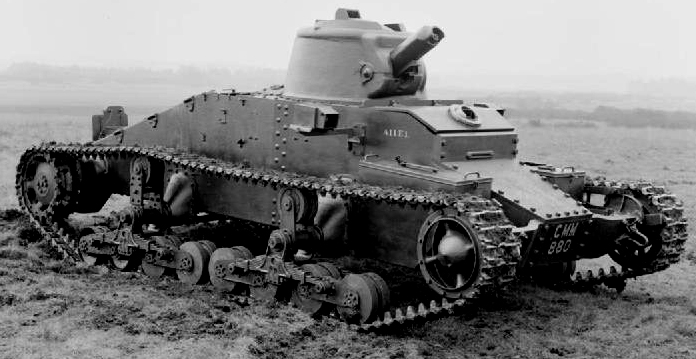
The A.11E1, the pilot model for the Infantry Tank Mk.I, here on trials.
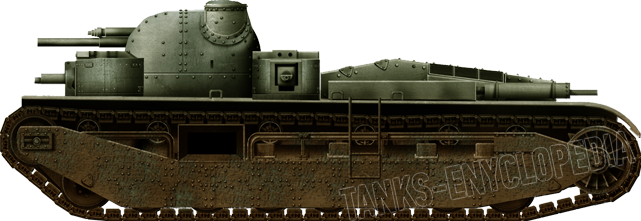
Tank Encylopedia’s own rendition of the AE1 Independent.
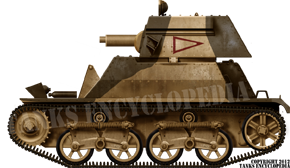
Light Tank Mk.IIA, unknown unit, probably Australian, East Africa, August 1940.
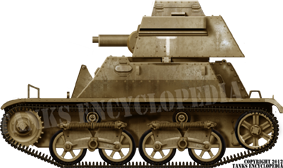
Light Tank Mk.IIB Indian Pattern, here with a recognizable square cupola, better engine, better hull cooling and a more powerful Meadows EPT 85 hp engine.
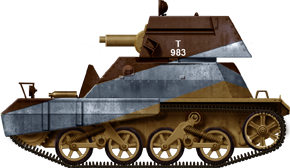
Light Tank Mk.II, 6th Australian Cavalry Division – Egypt, 1941.
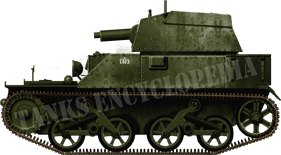
Light Tank Mk.III, the last of this lineage derived from the Mk.VI tankette.
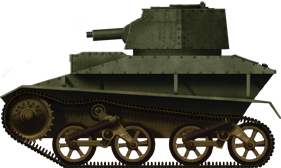
A.4E19 prototype.
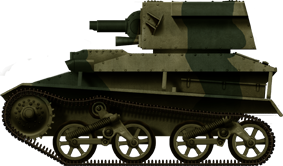
Regular Light Tank Mk.IV, Great Britain, 1939.
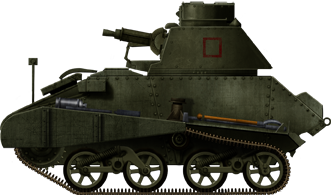
Early Light Mark V derived from the L3E1 prototype in 1934. The Horstmann suspension system was virtually unchanged.

Light Mark V, fully equipped, possibly used by the BEF for training in France, prior to May 1940.
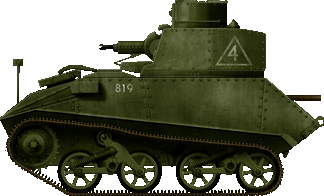
Light Tank Mk.VI, first batch vehicle, early 1937. Only a handful of these were produced, perhaps 30 or 40, and they were likely used, after 1939, as training machines, like the Mk.Vs.
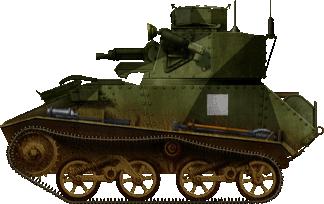
Light Mk.VIa of the British Expeditionary Force (BEF), western Belgium, May 1940.
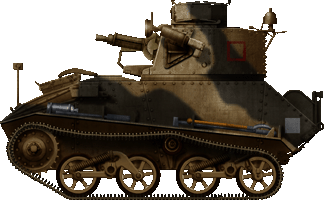
Vickers Mk.VIa Light Tank, B Squadron, 4/7th Royal Dragoon Guards, BEF, northern France, February 1940
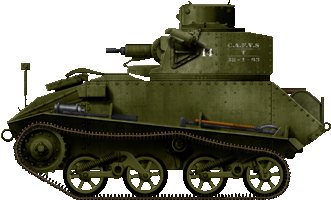
Light Mk.VIb of a C.A.F.V.T (Canadian Armoured Fighting Vehicle Training) unit, late 1940.
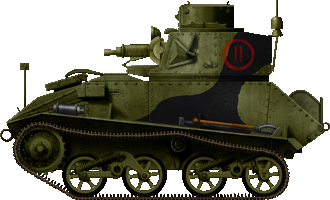
Light Mk.VIb of the 11th troop, C squadron, 2nd Royal Tank Regiment, France, May 1940.
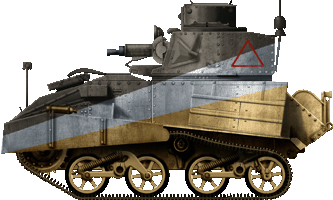
Light Mk.VIb, A Sqdn, 1st Battalion Royal Tank Regiment, 7th Armoured Division, Egypt, fall 1940.
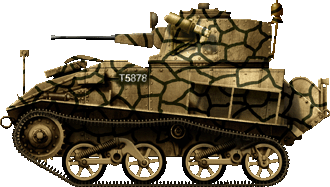
Light Mk.VIc, Malta, June 1942. This late version, produced until mid-1940, was reequipped with a high-velocity 15 mm (0.59 in) Besa machine-gun. The Besa heavy machine-gun had a better punch and accuracy than the Vickers cal.50 (12.7 mm). However, it also had poorer performances compared to the German 20 mm (0.79 in) that equipped the Panzer II. Its unusual method of cocking was tricky and needed careful maintenance.
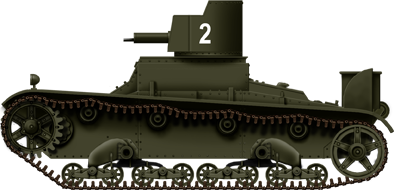
The first Vickers Mark Es were model As, the twin turret model, armed with two liquid-cooled Vickers machine guns. This one was part of the only four machines retained by the British army for testing and training purposes. Many Type A vehicles were sold abroad, but they were by far eclipsed by the Type B.
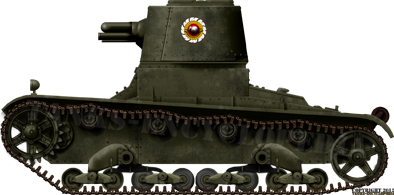
An early production Vickers E Type B, with the low-velocity 47 mm (1.85 in) gun. This one served with the Siamese army, which bought thirty Type Bs in 1933-34. They saw action in 1941 against French colonial forces, and duelled with the few French light tanks they encountered.
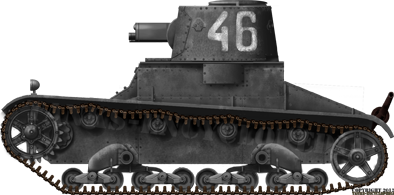
Bulgarian Vickers Mark F. Bulgaria bought twenty Mk.Fs, a modified version of the Mark E, mostly for training purpose. They were still in service at the beginning of WW2.
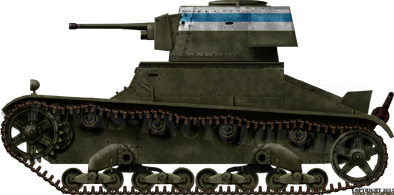
Finnish Vickers Mark F, modified with a Bofors 37 mm (1.46 in) gun. They only took part in one battle until the very end of the war with Russia in 1939.
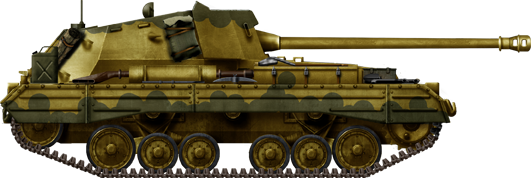
Archer Self Propelled 17 pdr, Valentine, Mk.I, Archer in Italy, winter 1944-45.
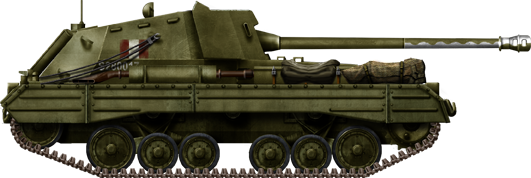
Archer in the Netherlands, winter 1944.
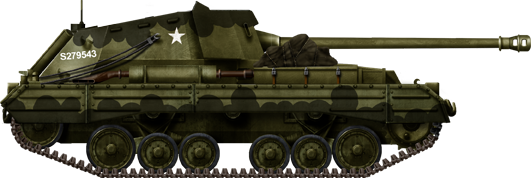
British Archer, east bank of the Rhine, 1944-45.
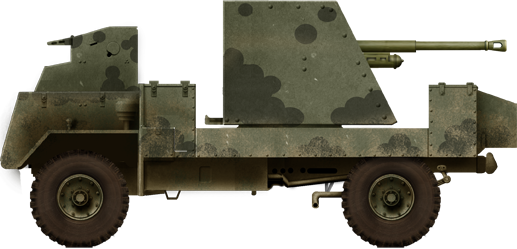
An AEC Mk.I Gun Carrier Deacon with an early green camouflaged livery, December 1942.
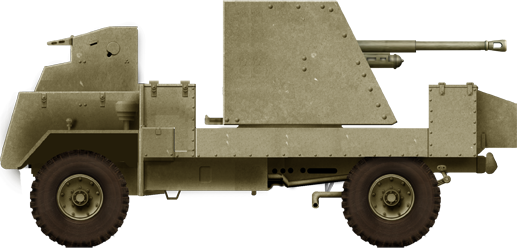
Standard AEC Mk.I Gun Carrier Deacon in desert livery, 1943.
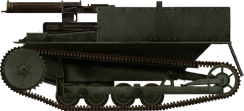
Early Mark VI model. It was an open model, completely unprotected from above. After a complete redesign, the model ended as the famous “Universal carrier”
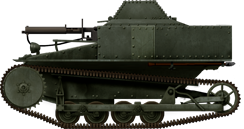
The main production model, also the most exported and built under license. It was, this time, completely protected from above, with two hexagonal domes for the crew members.
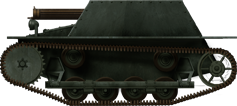
The late production model, only retained by the British army, and built by the Royal Ordnance Factory.
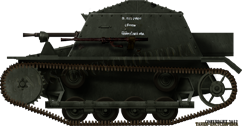
A Carden-Loyd Mk.VI of the Royal Thai army, January 16, 1941, Burapha Siamese army, battle of Phum Preav. 30 tankettes of the 1930 type and perhaps 30 others were purchased in 1935.
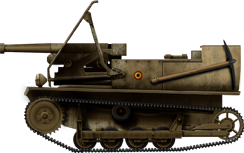
Belgian SA FRC 47mm, tank hunter, self-propelled gun. The Belgian Commission permanente de Motorisation purchased six tankettes of the Mark VI type in 1929, but they converted them into SPGs, equipped with the standard-issue S.A. 47 mm (1.85 in) built at Fonderie Royale des Canons (FRC), Liege. It was found more practical and effective to carry than to tow these guns. They were part of the Chasseurs Ardennais until 1938, then spread into two Régiments Cyclistes-Frontière, which ambushed a German column on May 10, 1940, alongside the Meuse river.
.png)
Captured Dingo Mk.I, designated Leichter PzKpfw Mk.I 202(e), DAK, Libya, 1941.
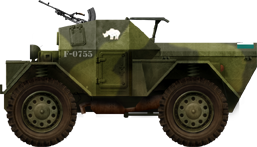
Dingo Mk.IA, British Expeditionary Force, 3rd RTR, 1st Armoured Division, Holland, summer 1940.
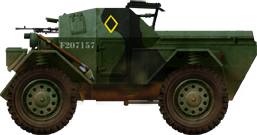
Dingo Mk.IA from the HQ squadron of the 1st Northamptonshire Yeomanry, 20th Armoured Brigade, 6th Armoured Division, training in Great Britain, 1941.
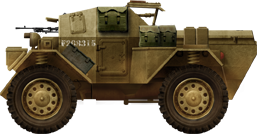
Dingo Mk.IA, Libya, fall 1940.
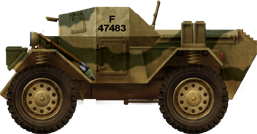
Daimler Dingo Mk.IB, Great Britain, fall 1941.
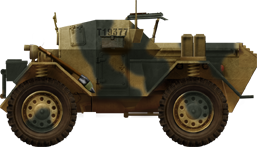
Dingo Mk.II, unknown reconnaissance unit, Western Europe, 1944.
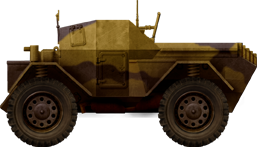
Dingo Mk.II, 4th Field Squadron RE, 7th Armoured Division, Libya, 1942.
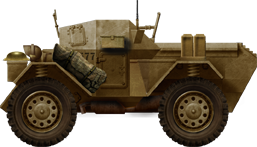
Dingo Mk.II attached to the reconnaissance battalion of the 7th RTR, VIIIth Army, Libya, fall 1942.
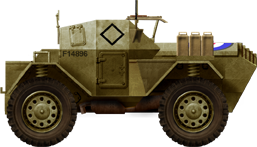
Dingo II, 2nd NZ Division HQ, El Alamein, November 1942.
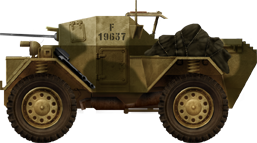
Dingo Mk.II with a Boys AT rifle, 23rd Armoured Battalion, 5th RTR, Tunisia, March 1943. (HD illustration)
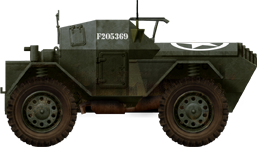
Dingo Mk.II, NZAC training center near the Red Sea, 1945.
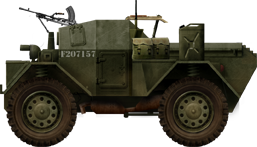
Dingo Mk.II, 11th Hussards, 7th RTR, Holland, winter 1944-45.
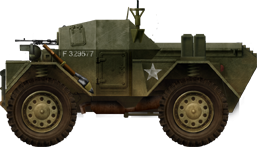
Dingo Mk.III, 11th Armoured Division, Holland, winter 1944-45.
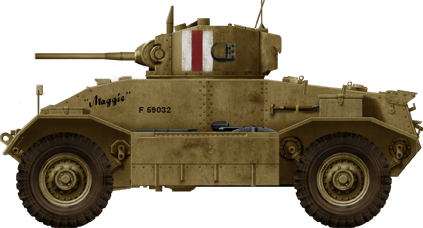
AEC Mark I, El Alamein, November 1942.
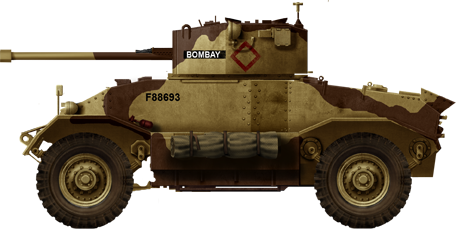
AEC Mark II, 10th Indian Infantry Division, Italy, 1943.
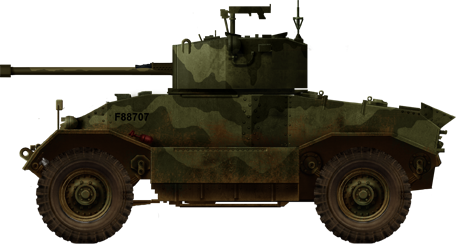
AEC Mark II, Italy, winter 1944 (now preserved at Bovington).

AEC Mark II used by the Yugoslav Army in 1945.
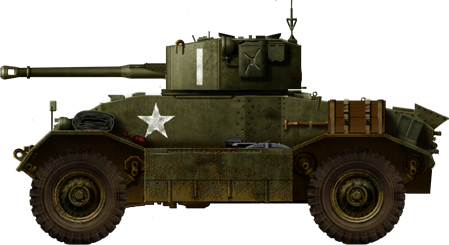
AEC Mark III, D Squadron, 2nd Household Regiment, VII corps, Normandy, 1944.
AEC Mk.III, 2nd British Army, North-West Europe, spring 1945.
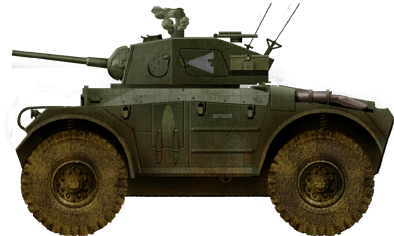
Coventry Armoured Car, early production version on trials, summer 1944.
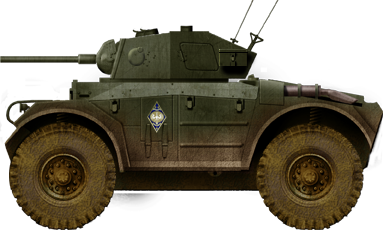
Coventry in French service, 2nd Tunisian Spahi, 5th Cuirassiers, Indochina, 1947-52.
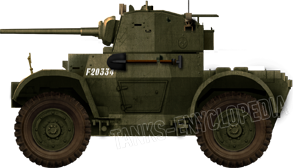
Daimler AC Mark I, green livery
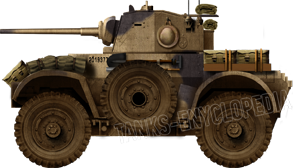
Daimler AC Mark I in 1942
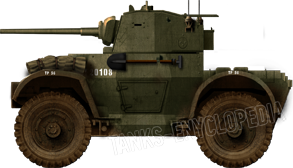
Daimler Armoured Car Mark 1, desert livery
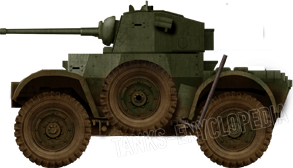
Daimler Mark II, RA 11th Hussars, 7th Armoured Division, Berlin, 1945
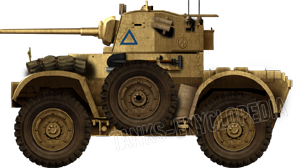
Daimler AC Mk.II of the “Desert Rats”, North Africa 1942
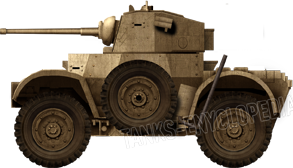
Daimmler Armoured car of the AR 7th Armoured Division, Egypt, 1942
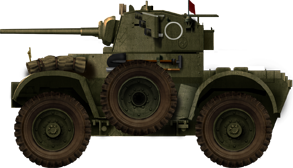
Postwar Daimler Mk.I training at Lulworth Ranges
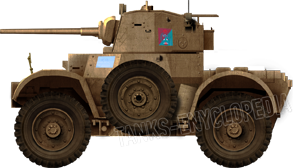
Daimler Mk.II of the Qatari Army today.
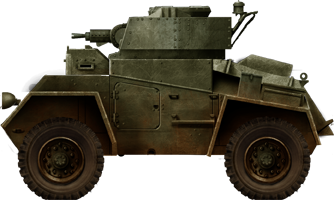
A Guy Armoured Car in 1939. It was the predecessor of the Humber Mark I.
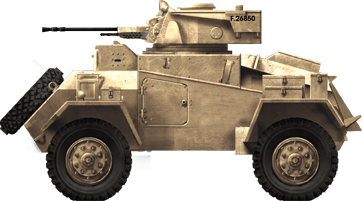
Humber Mark I, North Africa, 1941.
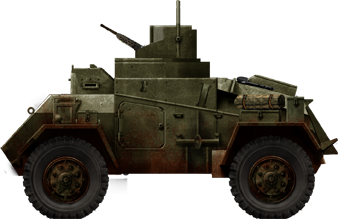
Humber Mark IA, Great Britain, 1942
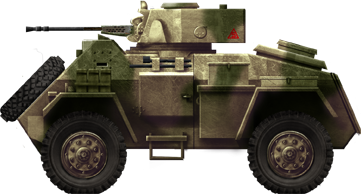
Humber Mark II, Italy, early 1944.
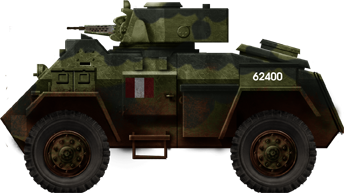
Canadian Humber Mark II in France, mid-1944. Notice the .50 cal’s short barrel.
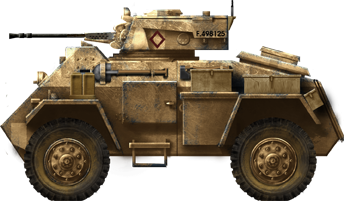
British Humber Mark III in Tunisia, early 1943.
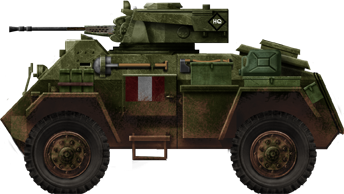
Humber Mark III attached to the recce battalion of the 1st Polish Armoured Division, Normandy, June 1944.
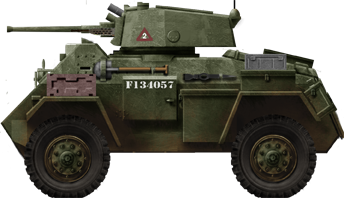
Humber Mark IV “Laughing Boy III”, from a British unit, The Netherlands, fall 1944.
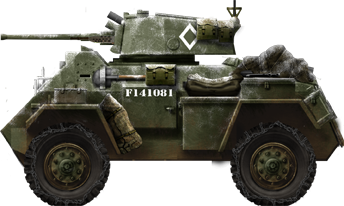
British Humber Mark IV in the Rhineland, winter 1944-45.
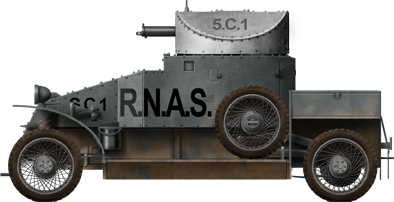
Lanchester armored car from the RNAS (Royal Naval Air Service), Dunkirk, 1915.
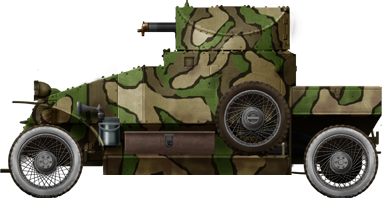
A camouflaged Lanchester, Flanders, 1916.
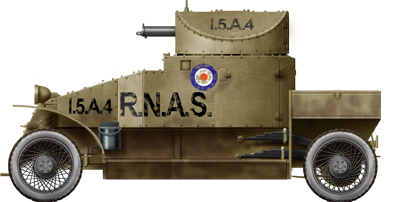
RNAS operating in Persia, 1916.
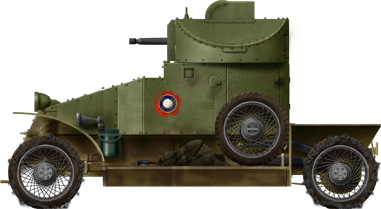
Russian Lanchester, Caucasus 1916. Notice the 37 mm (1.46 in) Hotchkiss, the small cupola above the turret, the absence of stowage boxes at the rear and the tires wrapped in mud chains in autumn.
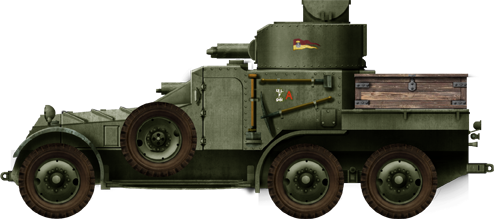
A Lanchster Mark I of the 12th Lancers. This was a heavily armed vehicle for the time, armed with a heavy MG and two Vickers medium MGs. The first could destroy light tanks when equipped with AP bullets.
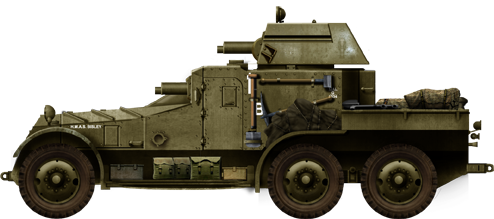
A vehicle of the 12th Lancers, B squadron in Malaya, 1941. This particular vehicle (now on display in a museum) was reequipped with a Light Tank Mark III turret and had only two Vickers 0.3 in machine guns. The Lanchester 6×4 had good off-road capabilities and was rugged and reliable. However, it was too heavy and slow for effective operations in reconnaissance units.
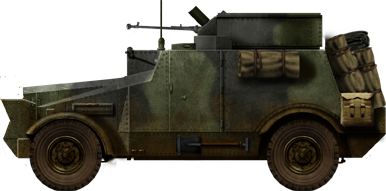
Morris CS9 of the 12th Lancers, British Expeditionary Force (BEF), Franco-Belgian frontier, May 1940.

Morris CS9 of the 11th Hussars, Libya, 1942.
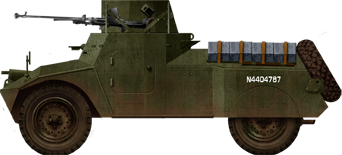
Morris Mk.I, early production version, Great Britain, 1941.
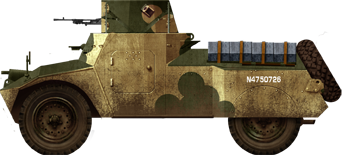
Morris Mk.I in North Africa, now preserved at Bovington.
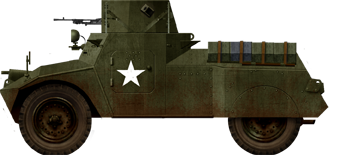
Morris LRC Mk.II in Normandy, summer 1944.
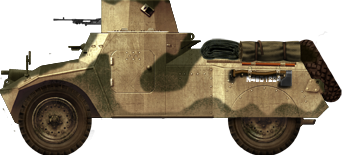
Morris LRC Mk.II in Tunisia, RAF patrol guard, now preserved at Duxford.
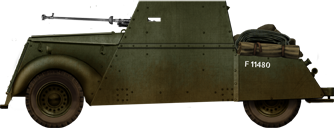
Beaverette Mark I. Notice the rib going along the side of the vehicle and the vertical radiator grills.
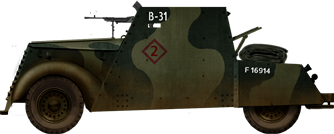
Beaverette Mark II, with the standard camouflage. Notice the lack of the rib from the Mark I and the horizontal radiator grills.

Beaverette Mark III, early type armed with a Boys 0.5 in (12.7 in) AT rifle.
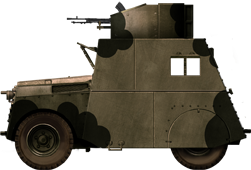
Beaverette Mark III with Bren gun and “Mickey Mouse” camouflage.
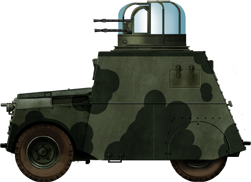
Beaverette Mark III with a Boulton-Paul quad 0.3 in (7.62 mm) turret
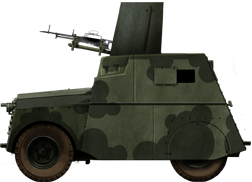
Beaverette Mark IV with a twin Vickers LMGs mount. Notice the redesigned armor.
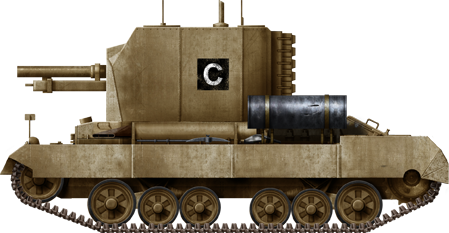
Ordnance QF 25 pdr on Carrier Valentine 25-pdr Mk.I “Bishop” of the VIIIth Army, El Alamein, fall 1942.
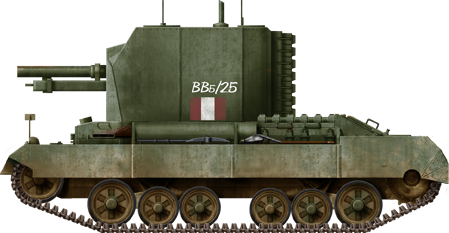
Bishop of the VIIIth Army in Southern Italy, February 1944.
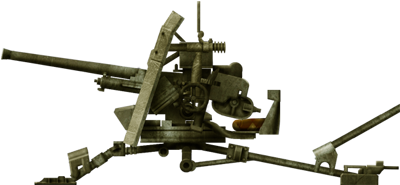
The standard 1939 2-pounder was the main infantry antitank weapon in service with the BEF in may-june 1940.
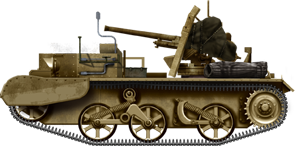
A 2 Pounder Anti-tank Gun Carrier (Universal Carrier) used by Australian forces in North Africa, 1941.
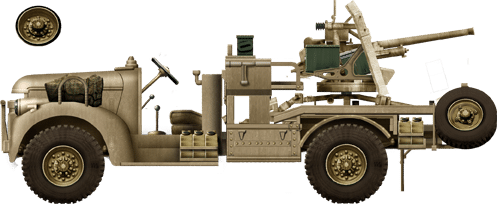
Chevrolet 30 CWT (WA/WB) 2pdr portee, the same type used by the LRDG in North Africa. This was a widespread solution, also declined on the Morris 15 cwt truck, CMP Ford F30 or Chevrolet C30, until the US-supplied lend-lease M10 tank hunter made them obsolete.

Tank Encylopedia’s own rendition of the TOG-1 in 1940.
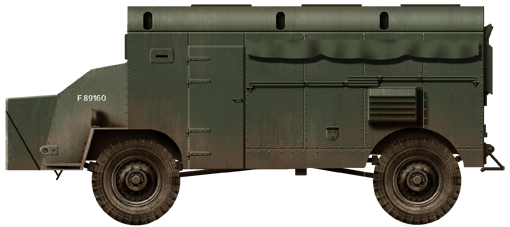
Basic AEC 4×4 ACV in UK, may-june 1941.
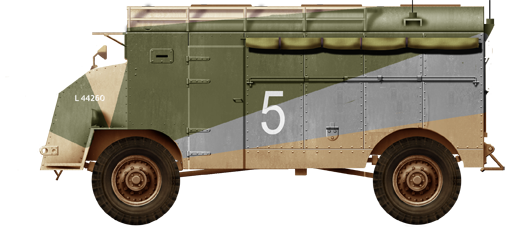
AEC 4×4 in North Africa, 7th armoured division, December 1941
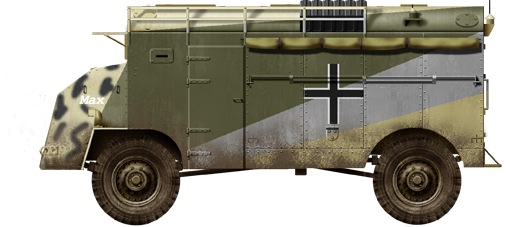
Captured Rommel’s “Max” command car. Both vehicles were called “Max” and “moritz” after popular XIX Boyish Pranks by author Wilhelm Busch published in 1865.
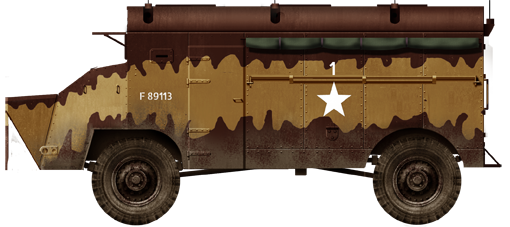
Dorchester in North Africa, Tunisia, 1943 with a wavy “spiked” dark brown/sand yellow pattern.
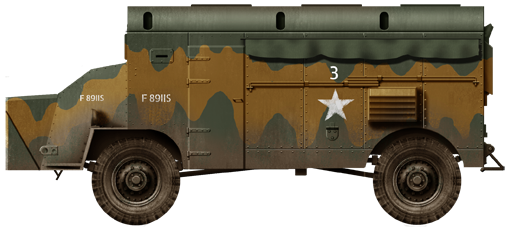
AEC 4×4 ACV in Normandy, summer 1944, notice a two-tone dark green and olive camouflage variant in use until the end of WW2. When stationary, they were also often heavily camouflaged with foliage, using the stretched canvas extensions to create a large open space.
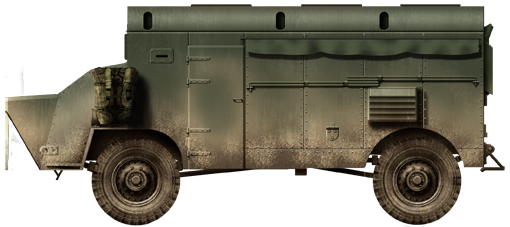
A Pakistani Dorchester during the 1965 Indo-Pakistani war.
British Churchill Tank – Tank Encyclopedia Support Shirt
Sally forth in with confidence in this Churchill tee. A portion of the proceeds from this purchase will support Tank Encyclopedia, a military history research project.
 Forgotten Tanks and Guns of the 1920s, 1930s and 1940s
Forgotten Tanks and Guns of the 1920s, 1930s and 1940s
By David Lister
History forgets. Files are lost and mislaid. But this book seeks to shine a light, offering a collection of cutting edge pieces of historical research detailing some of the most fascinating arms and armament projects from the 1920s to the end of the 1940’s, nearly all of which had previously been lost to history.Included here are records from the UK’s MI10 (the forerunner of GCHQ) which tell the story of the mighty Japanese heavy tanks and their service during the Second World War.
Buy this book on Amazon!
 TOG-2R Heavy Tank Service Manual
TOG-2R Heavy Tank Service Manual
By Andrew Hills
Service Manual for the British Super-Heavy tank TOG-2R. Pieced together from surviving records this manual was written in sections during the long development of the tank and was stopped when the project was terminated. As such the manual is incomplete but has been recreated as close as possible to what the original manual would have looked like had the tank entered production.FWD Publishing
Buy this book on Amazon!
 TOG-2* Heavy Tank Service Manual
TOG-2* Heavy Tank Service Manual
By Andrew Hills
Service Manual for the British Super-Heavy tank TOG-2*. Pieced together from surviving records, this manual was written in sections during the long development of the tank and was stopped when the project was terminated. As such the manual is incomplete but has been recreated as close as possible to what the original manual would have looked like had the tank entered production.
FWD Publishing
Buy this book on Amazon!
By Andrew Hills
The previously untold story of the Special Vehicle Development Committee, better known as ‘The Old Gang’ or by the abbreviation ‘TOG’. The SVDC managed in very short time to design more than one vehicle to accomplish this seemingly impossible task and built tanks bearing their acronym as TOG-1 and TOG-2. FWD Publishing

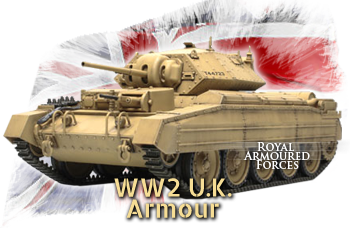

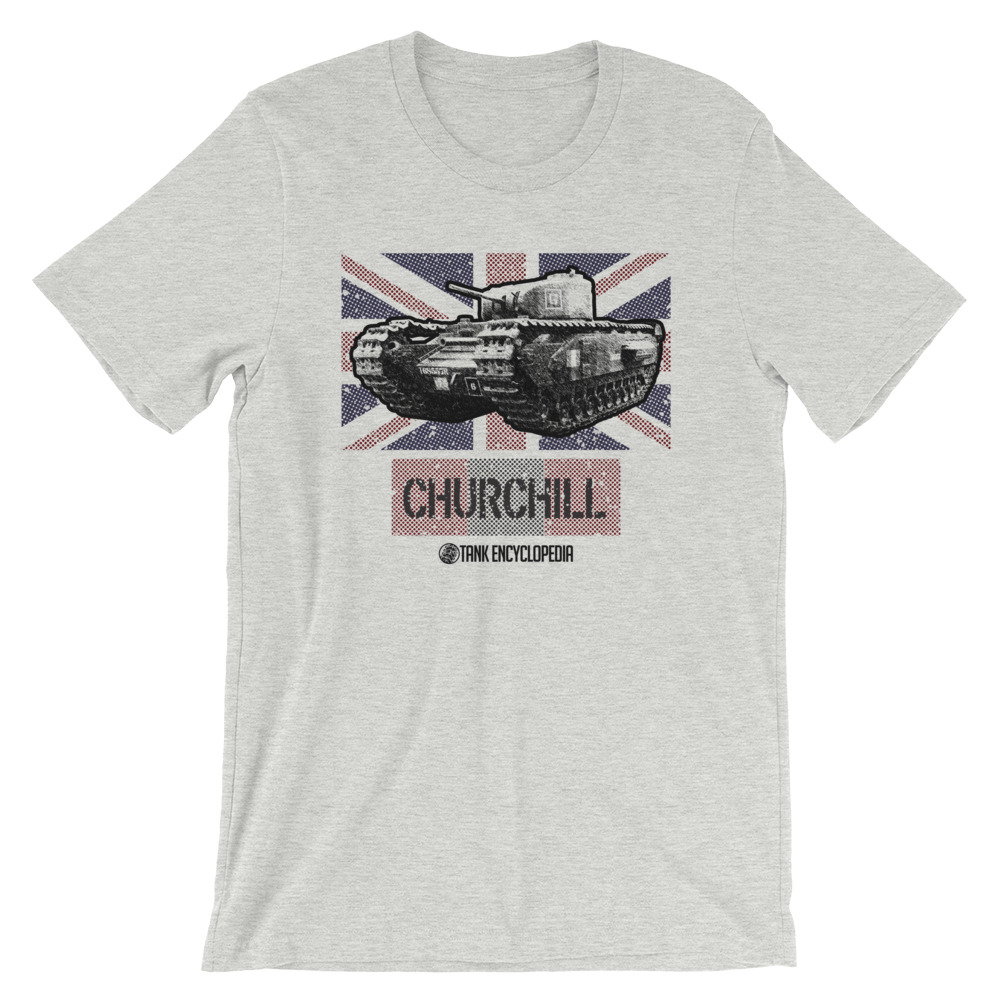
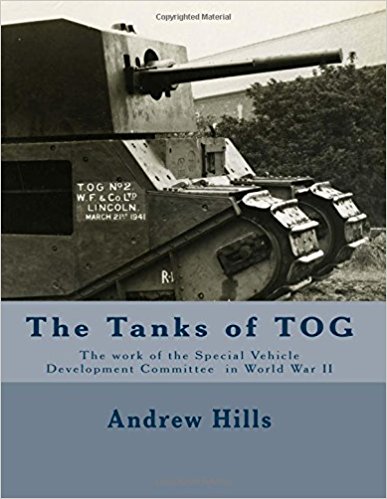
42 replies on “United Kingdom of Great Britain and Northern Ireland (WW2)”
Nice photo of the A34 Comet on this page, but I can’t seem to find this tank’s own entry!? I take it this site is a work in progress? I do hope the Comet gets its own page someday; it deserves one more than some others here, IMHO. Nice reference site.
Yes, every vehicle will get an article sometime in the future.
Do you have a table that cross references British guns to standard or similar guns measured in inches or millimeters?
that tog 1
What happened to the Tortoise self propelled gun which was sent to Germany for trials in 1948?
Two were used for practice targets and destroyed.
1 is in a museum.
That leaves three unaccounted for – the one that was sent to Germany and two mysteriously @missing@.
This is private interest and not for publication.
Thank you and regards
Johannesburg, South Africa
Would like more information on the Ariel flags in the desert campain
Hello Paul,
What is an Ariel flag?
Hi in World of Tanks there’s a British Tank hunter called the ALECTO I don’t think it was put into production but it would be great if you could include it on
The site.
Hello Mr. Barratt. There was Such a vehicle, a prototype built on the Chassis of the Tetrarch. A Tetrarch Article is in the works, so it may just debut on there.
i that it was based on the harry hopkins light tank mk VIII, not VII
good job guys
so the tortoise was never made that sucks
It was actually made. I think that there was 8 built,
However I don’t know what happen after they built it.I only know one is preserved in bovington tank museum.
Btw ,the tortoise is a beast
Can u make an article about the Achilles Tank destroyer and the Tog 2.This tanks are interesting
The Vickers 6 ton above is actually Finnish, armed with a Soviet 45mm, not Portuguese .
Yeah, that 6-ton is in Finland, same with a T-28E. Also, maybe the Birch gun? If not a separate article, may I suggest it to be in the Vickers Medium Mk. II article? It was actually a great artillery, I would love if you guys did an article on it.
Could you do an article on: the alecto, the avenger, the challenger(separate), The harry hopkins if not all?
I have a photo of my father who was in the RHA sitting on a tank in 1944/5 and from your information I see it was a Cruiser Vlll Cromwell . How interesting but he was a L/Bdr and the company clerk and kept out of dangerous situations hence my birth in 1947!
About the Cromwell; ‘and equipped with the largely available and very efficient QF 6-pdr (76.2 mm/3 in) gun.’
the 6-pounder is a 57mm. The 76.2mm described is the 17 pounder, which wasen’t mounted on the (regular) cromwell.
We got it right 2 times and wrong once 😀
Thanks for letting us know, it was corrected!
Thanks for the article, was very enlightening.
So I was wondering if the Churchill Gun Carriage will ever get its own page. Seeing as how it was a big step for the brits to mount a large caliber gun in a superstructure on a churchill, id say it deserves some love.
Actually, the article is already published!
https://www.tanks-encyclopedia.com/ww2/gb/a22d-churchill-gun-carrier
Is it just me or does the Matilda II not have a page?
I’m afraid it’s you! https://www.tanks-encyclopedia.com/ww2/gb/Infantry_Tank_Matilda_II.php.
– TE Moderator
I wonder if anyone can help me please. I have 3 Questions. When they shipped Sherman tanks to England, and transported them on the railways. Did they remove the Machine guns from the tank ? what colour where they painted? and did they have any marking on the tank.
Hope someone can help me with these questions.
Thanks in advance.
John B
Hello John,
They didn’t have the machine-guns mounted it seems.
They were probably painted in olive-green, as most US tanks.
Probably few markings until their units applied them.
Some photos:
https://i.pinimg.com/originals/2f/14/7b/2f147b05ad5a1607b5ddd3d59fb6f3e9.jpg
https://www.worldwarphotos.info/wp-content/gallery/usa/tanks/m4-sherman-tank/M4A2_Sherman_Tanks_On_Railroad_Cars.jpg
http://silverhawkauthor.com/images/site_graphics/Armour/Ironsides/Bangor__Aroostook_Flat_Car_71710_with_U.S._Army_Tank._MIKAN_No._3285353.jpg
In the US:
http://i155.photobucket.com/albums/s319/centralpullman/Prototype%20Photos/Tank_zpsv1cn7s9s.jpg
The picture of the Cromwell states it was powered by a RR Merlin engine. To be correct this was not so. It was a downrated Merlin engine and named Meteor.
Corrected, thank you!
Thanks for the article, nice information
Where ware all the british armoured cars left?
What has happened to tanks encyclopedia? So many tanks and armoured cars seem to be ripped off??
Dozens of tanks and all armoured cars (except Guy Armoured car) is ripped off??
Over the two last years, I see only money greed via PayPal and Patreon and destruction of the encyclopedia: First that new layout with “scroll wolve feature” and now 75% of all tanks and amoured cars vanished …
If I am wrong, tell me where all the good stuff is gone for and why I should support that destruction of the former best tanks encyclopedia with money??
AND: Would you redact my reply, because it is no sweet talk to the devs? If yes, what has happened to free speech as well in the world??
Hello Teotwawki,
Indeed, a lot of articles have been withdrawn recently because they no longer meet our standards of quality from a historical point of view. It was thus decided within the Tank Encyclopedia team to withdraw them until we can rewrite them (which we are in the progress of doing for a lot of them). We will be making a social media post tomorrow.
For the change to a single column, that was intentionally done because we have found that the two-column format we used to have was no longer compatible with the large text-sizes our articles have grown to have. We do not intend to return to double columns. Part of the problem with the new format is that we have to adapt the photos from the old articles to no longer take so much space. That is being done, but given the large number of articles and current activities, it is taking time.
The Encyclopedia is far from destroyed. This was a move we have decided to do in order to improve our reputation and the general quality of the information given on the website. None of the illustrations have been withdrawn, they are all available on the nation and era pages (such as this one).
As for greediness, I honestly do not understand what you mean. All the funds we receive through donations (and through other income sources such as merchandise shop, Amazon ads, magazine sales, guest posts) are used to pay for the illustrations on the website. You can see our financial sheet here:
https://docs.google.com/spreadsheets/d/1Nkeuu4gI9vTR4Lc2RDN1je-mp-UP2nZGKHfoorXNvbU/edit?usp=sharing
The writer team and the admin team are working on a purely voluntary basis, nobody is getting paid, including me!
As for censorship, we don’t do that based on opinion but based on language. As you can observe, the first word of your post has been changed, but the rest is published as was submitted.
Teotwawki some of the other articles are in the archives you can check them out at the more sections.
Class. So much information on tanks. At one time he was fond of tank models and their history. I was very happy when I found your site.
An interesting article but all of the artwork on camouflage in the desert is fiction, either in patterns or both in colours. Some of the rest is doubtful too. Where do you get this from?
I was looking at the index and it said something about the A.40 Commodore, though searching it up shows nothing, did that tank ever exist?
sorta the bluprints were made no prototype.
I was wondering if you have the Churchill Mk III, I have been doing research on the battle of Dieppe and it was the main tank used in the battle. I was looking for more information on it and can’t find it here.
Hi Rowan, you can find the Churchill and all its variants in the archived article here: https://tank-afv.com/ww2/gb/A22_Churchill_Tank.php
Cheers !
David
There appears to be an error in the A27L section. It reads “The suspension consisted of SIX unevenly spaced large rubber-clad roadwheels per side, rear drive sprockets and front idlers.” which it allegedly got from the Crusader, but only the Crusader and the Challenger appear to have 6 road wheels per side.
Correction-I see that the Crusader also has only 5 road wheels per side.